



Find all of your laboratory and workplace safety supplies at Safety Emporium!
 Vapor pressure |
 Glossary Index |
 Vertigo |
| MSDS Topics |
Free Sites | FAQ's | Regulations | Glossary | Software | Suppliers |
| Books | Forum | Poll | Fun stuff | Quiz | Store | |
| Understand your MSDS with the MS-Demystifier | Search ALL our MSDS info | |||||
Ventilation is the process of supplying fresh air air to an enclosed space in order to refresh/remove/replace the existing atmosphere. Ventilation is commonly used to remove contaminants such as fumes, dusts or vapors and provide a healthy and safe working environment; in other words, it is an engineering control. Ventilation can be accomplished by natural means (e.g., opening a window) or mechanical means (e.g., fans or blowers).
By itself, the term does not indicate whether the exhausted air is filtered or cleaned before being discharged. Likewise, it does not indicate whether the incoming ("make-up") air is treated is heated, cooled or otherwise treated. Ideally, ventilation provides constant temperature, humidity and air quality within the enclosed space.
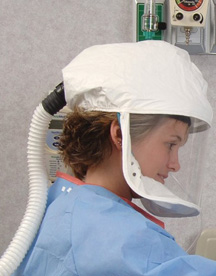
Breathe easy with respirators and accessories from Safety Emporium.
Ventilation is a critical concern in many occupational activities that generate dusts, fumes, mists, and vapors. Examples of such activities include welding, grinding, soldering, brazing, sanding, painting, finishing, and the use of volatile and/or flammable chemicals. It has also become an important issue for schools, restaurants and other spaces given the ease with which Covid-19 is transmitted through heating and cooling systems.
One can reduce the need for ventilation by reducing or minimizing the amount of airborne contaminant generated. Examples of such practices include:
Ventilation systems for the control of hazardous materials in the workplace can be broken into two broad classes:
Local exhaust ventilation is clearly the preferred method whenever feasible! In addition, local exhaust ventilation moves a much smaller quanitity of air much more efficiently - this results in large savings in heating and cooling costs.
Local exhaust ventilation systems typically have the following components:
Some specific examples of local exhaust ventilation systems include:
| Fume Hoods - These specialized, fixed cabinets contain and draw in contaminants and vent the contaminated air remotely (usually through a stack on the roof of the building). A good supply of properly conditioned makeup air is required so these systems require professional installation and maintenance. | 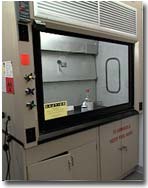 |
| Ventilating Blowers - These have an inlet and outlet hose to collect and move contaminated air away from the source. The model shown here (without the hoses) is portable, making it ideal for use in a garage or workshop. Ventilating blowers generally have the lowest capital cost of the systems shown. | 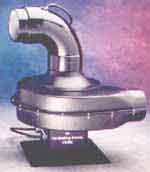 |
| Fume Extractors - These are small air cleaning devices used to filter mists, dusts and fumes. The filtered air is recycled - making it good for many common dusts. Because the air is recycled, this is not a suitable choice for toxic or flammable vapors. |  |
| Filtering Stations - Are fundamentally similar to the fume extractors shown above, but have better mobility. | 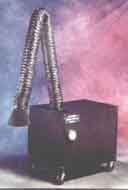 |
| Down Draft Work Stations or Tables - These use a blower to pull air away from the worker through slots or holes in the table top or work surface. Down draft stations can have a filtering/recirculating configuration (like the filtering station above) or the exhaust can be ducted to a remote point (like the ventilating blower above). |  |
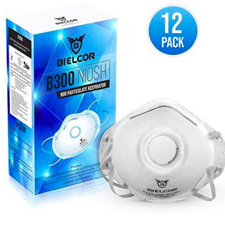
Get your PPE such as NIOSH-approved N99 masks and face shields from Safety Emporium.
NOTE: We may collect a share of sales or other compensation from the links in the following list:
Some Safety Data Sheets' will contain specific mention of engineering controls such as local exhaust ventilation. These should be found in Section 8 (exposure controls/personal protection). Remember, the preferred methods for reducing chemical exposure, in order of general effectiveness, are:
Also remember that flammable materials or combustible dusts can be ignited if your ventilation system is not properly designed and maintained.
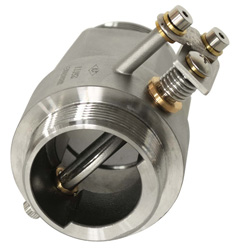
Vent your flammable storage safety cabinets safely with Safe-T-Vent thermally-actuated dampers from Safety Emporium.
See also: administrative controls, dust, engineering controls, fume, personal protective equipment (PPE), respirator.
Additional definitions from Google and OneLook.
Entry last updated: Sunday, February 6, 2022. This page is copyright 2000-2025 by ILPI. Unauthorized duplication or posting on other web sites is expressly prohibited. Send suggestions, comments, and new entry desires (include the URL if applicable) to us by email.
Disclaimer: The information contained herein is believed to be true and accurate, however ILPI makes no guarantees concerning the veracity of any statement. Use of any information on this page is at the reader's own risk. ILPI strongly encourages the reader to consult the appropriate local, state and federal agencies concerning the matters discussed herein.